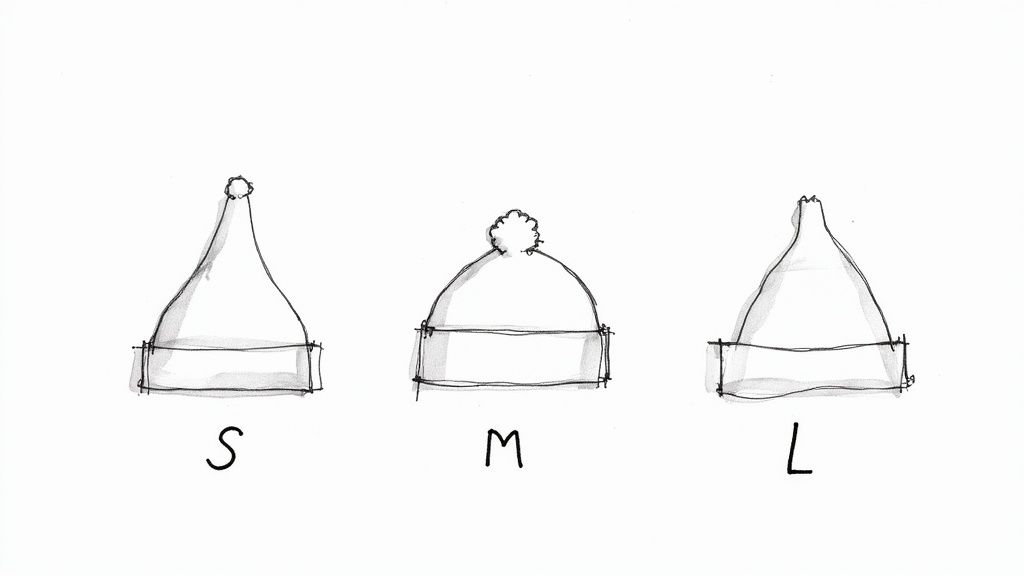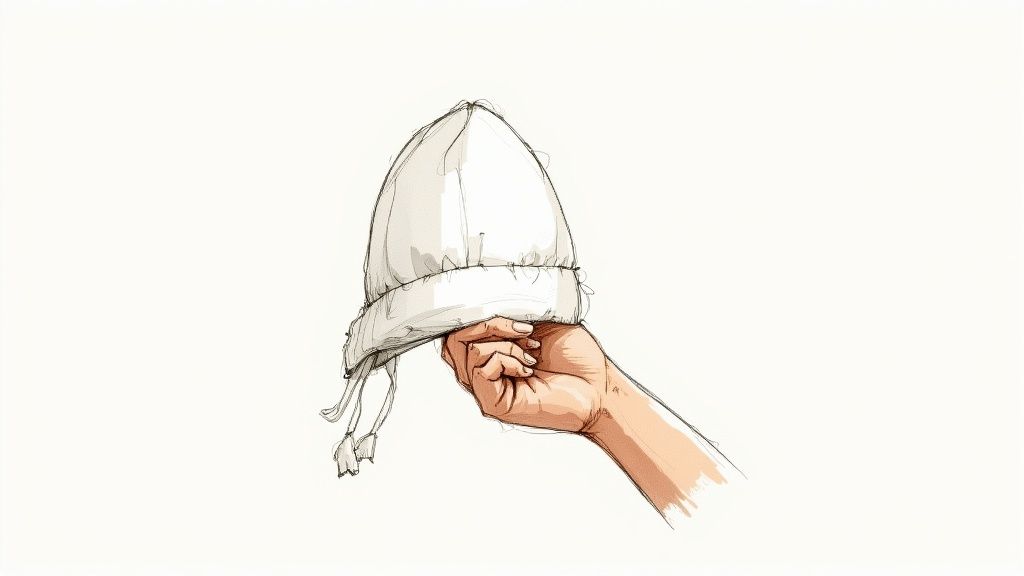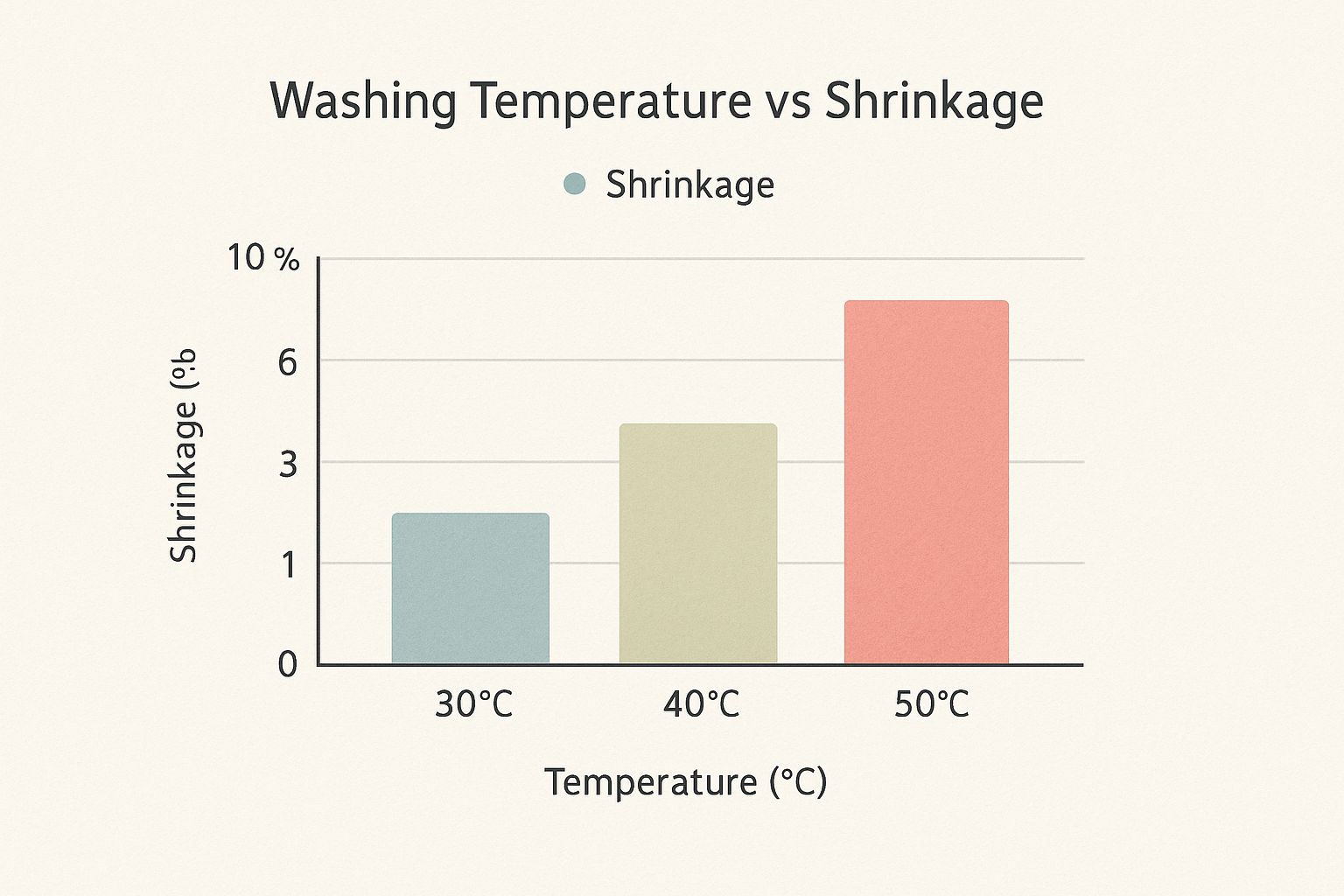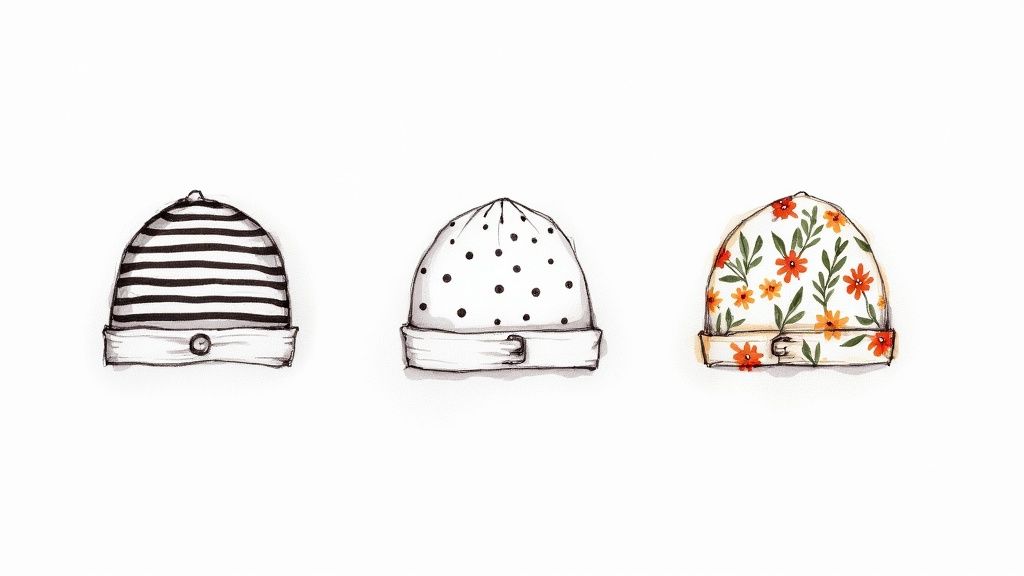Choisir le bon bonnet pour votre bébé ne se résume pas à trouver un joli accessoire. C'est l'une des premières petites décisions à prendre pour assurer sa sécurité et son confort. Un bonnet en coton pour bébé n'est pas seulement une tradition ; c'est un choix judicieux qui offre une respirabilité essentielle et une protection douce pour la peau incroyablement délicate du nouveau-né. Fabriqué en fibres naturelles, il n'est pas étonnant qu'il soit le choix numéro un des parents et des pédiatres.
Pourquoi le coton est roi pour le bonnet de votre bébé
Quand on est jeune parent, chaque petit détail compte, surtout en ce qui concerne ce qui touche la peau de bébé. On trouve des bonnets fabriqués dans toutes sortes de matières, mais le coton est toujours le meilleur. Ses qualités naturelles sont parfaitement adaptées aux besoins d'un nouveau-né, faisant du bonnet en coton pour bébé le choix idéal pour le confort et la sécurité.
Imaginez : les tissus synthétiques comme le polyester ou l'acrylique, c'est comme fermer hermétiquement les fenêtres par une chaude journée. Ils retiennent la chaleur et l'humidité, ce qui peut provoquer une surchauffe et un inconfort rapide chez un bébé, qui ne sait pas encore réguler sa température. Un bonnet en pur coton , en revanche, c'est comme ouvrir une fenêtre avec une moustiquaire. Il laisse passer une légère brise, gardant votre bébé bien au chaud sans qu'il ne transpire ni ne soit moite. Cette circulation d'air naturelle est absolument cruciale.
La véritable magie d'un bonnet en pur coton réside dans sa capacité à évacuer l'humidité de la peau tout en laissant l'air circuler. Cette caractéristique simple est essentielle pour prévenir les irritations cutanées et assurer le confort et la sécurité de votre bébé, que vous soyez bien au chaud à l'intérieur ou en promenade.
De plus, le coton est naturellement hypoallergénique. La peau d'un nouveau-né est si jeune et fine qu'elle est sujette aux irritations dues aux textures rugueuses ou aux produits chimiques parfois présents dans d'autres tissus. Les fibres douces et lisses du coton sont incroyablement délicates, vous n'avez donc pas à craindre d'irritations. Un bonnet en coton pour bébé constitue donc une première protection idéale pour sa tête sensible.
Voici un bref aperçu des raisons pour lesquelles le coton est le meilleur choix :
- Respirabilité incroyable : il aide à maintenir la température de votre bébé juste en laissant s'échapper l'excès de chaleur, ce qui réduit considérablement le risque de surchauffe.
- Naturellement hypoallergénique : le coton est doux même pour les peaux les plus sensibles, sans les substances agressives souvent utilisées pour traiter les tissus synthétiques.
- Douceur imbattable : les fibres naturelles donnent l'impression d'un câlin doux, et non d'une distraction qui démange, garantissant que votre bébé reste heureux et confortable.
L'héritage durable des chapeaux pour bébés au Royaume-Uni
 Ce simple bonnet en coton que l'on voit sur les nouveau-nés est bien plus qu'un simple accessoire moderne. Il est porteur d'une riche histoire, étroitement liée au célèbre patrimoine textile du Royaume-Uni. L'acte familier de placer un bonnet souple sur la tête d'un bébé est une tradition née d'une pure nécessité, affinée par l'innovation industrielle et transmise avec amour de génération en génération dans les familles britanniques.
Ce simple bonnet en coton que l'on voit sur les nouveau-nés est bien plus qu'un simple accessoire moderne. Il est porteur d'une riche histoire, étroitement liée au célèbre patrimoine textile du Royaume-Uni. L'acte familier de placer un bonnet souple sur la tête d'un bébé est une tradition née d'une pure nécessité, affinée par l'innovation industrielle et transmise avec amour de génération en génération dans les familles britanniques.
Cette histoire nous ramène à l'histoire de la chapellerie anglaise, où la fonctionnalité et le style du quotidien se sont rencontrés. Pendant des siècles, les parents se sont souciés de garder leurs enfants au chaud et à l'abri du climat britannique, réputé imprévisible. À mesure que le besoin de chapeaux confortables et fiables pour les nourrissons s'est accru, la demande de matières douces et respirantes comme le coton a également augmenté.
Le cœur de la chapellerie en Angleterre
Au cœur de tout cela se trouvaient Luton et le Bedfordshire. Pendant plus de 200 ans, cette région fut un leader mondial de la production de chapeaux. Si elle était réputée pour ses élégants chapeaux de paille pour dames, son expertise couvrait toutes sortes de couvre-chefs, notamment les chapeaux en coton doux et doublés de coton, parfaits pour les bébés.
L'héritage de villes comme Luton ne réside pas seulement dans les chiffres de production ; il réside également dans la promotion d'une culture où un chapeau bien fait - pour un adulte ou un nouveau-né - était considéré comme un élément essentiel de la vie quotidienne et de la protection.
Cette région rurale et paisible est devenue un pôle industriel dynamique, abritant des milliers d'artisans et d'ouvriers. Leurs savoir-faire allaient du tressage de la paille à la couture soignée de doublures en coton doux. Le chapeau en coton pour bébé tel que nous le connaissons est directement lié à ce commerce florissant. À son apogée dans les années 1930, la région produisait le nombre incroyable de 70 millions de chapeaux par an . Ce chiffre stupéfiant, qui comprenait de nombreux chapeaux pour enfants et bébés, témoigne de l'importance cruciale de ces articles. Pour en savoir plus sur cette riche histoire, consultez le site web « Histoires culturelles » .
De la puissance industrielle à la tradition chérie
Lorsque l'industrie de la chapellerie a commencé à décliner après la Seconde Guerre mondiale, en raison de l'évolution des modes et de l'essor des importations bon marché, ce fut la fin d'une époque. Mais à cette époque, la tradition du chapeau pour bébé était déjà profondément ancrée dans la vie familiale britannique. L'importance accordée à la qualité des matières comme le coton et au savoir-faire artisanal de l'époque a établi la norme du chapeau moderne en coton pour bébé que nous apprécions aujourd'hui.
Les principes fondamentaux de cette industrie historique sont toujours aussi importants aujourd'hui :
- Praticité : La première fonction d'un chapeau a toujours été de fournir chaleur et protection.
- Confort : Les tissus doux comme le coton étaient indispensables pour la peau délicate d'un bébé.
- Artisanat : Qu'il soit cousu à la main ou fabriqué en usine, la qualité était primordiale.
C'est cet héritage qui explique pourquoi un simple chapeau en coton n'est jamais négligé. C'est un vêtement précieux qui relie les parents d'aujourd'hui à une longue lignée de familles qui ont compris l'importance de protéger et de protéger leurs enfants, à commencer par ce tout premier chapeau si important.
Guide des parents sur les différents tissus en coton

Lorsque vous cherchez un bonnet en coton pour bébé , vous tomberez probablement sur des étiquettes comme « biologique » ou « Pima ». On pourrait croire que tous les cotons se valent, mais ces petits mots révèlent de grandes différences de douceur, de durabilité et de fabrication. En les connaissant bien, vous pourrez choisir en toute confiance le bonnet en coton idéal pour votre bébé et les valeurs de votre famille.
C'est comme choisir des pommes à la ferme. Certaines sont croquantes, d'autres sucrées, et d'autres encore cultivées sans pesticides. Chaque type de coton offre des avantages uniques ; découvrons donc ceux que vous verrez le plus souvent.
Coton conventionnel
C'est le coton le plus répandu au monde et celui que l'on retrouve dans la plupart des vêtements du quotidien. Abordable, il est efficace et offre la respirabilité et la douceur classiques du coton.
L'inconvénient ? Sa production repose généralement sur des pesticides et des engrais synthétiques. Si le tissu fini est parfaitement sûr à porter, de nombreux parents préfèrent le coton cultivé de manière plus naturelle, surtout pour un vêtement qui sera en contact direct avec la peau sensible d'un nouveau-né.
Coton biologique
Le coton biologique est une version « de la ferme à la table » du tissu. Il est cultivé sans pesticides de synthèse, OGM ni engrais chimiques agressifs. Cette approche est bien plus respectueuse de l'environnement et permet de créer une fibre de coton incroyablement pure et douce.
La peau d'un nouveau-né est jusqu'à cinq fois plus fine et absorbante que celle d'un adulte. Choisir du coton bio vous offre une tranquillité d'esprit supplémentaire : le tissu en contact avec son cuir chevelu délicat est exempt de résidus chimiques. C'est donc un excellent choix pour réduire tout risque d'irritation.
Opter pour le coton bio, c'est aussi soutenir un écosystème agricole plus sain et plus durable. Pour en savoir plus, consultez notre guide des vêtements éthiques pour bébé, qui vous aidera à faire des choix responsables pour votre tout-petit.
Coton Pima
Immédiatement reconnaissable à son toucher luxueux, le coton Pima est une variété haut de gamme aux fibres extra-longues. Imaginez-vous essayer de tordre plusieurs brins de fils courts plutôt que quelques brins très longs. Les fils plus longs créent un fil nettement plus lisse, plus résistant et plus résistant.
Il en résulte un tissu en coton qui est :
- Incroyablement doux : le coton Pima a une texture soyeuse qui procure une sensation incroyable sur la peau.
- Très résistant : il résiste parfaitement au lavage et à l'usure, au boulochage, à la décoloration et à l'étirement. Un chapeau en coton Pima conservera sa forme et sa douceur longtemps.
- Plus absorbant : il évacue parfaitement l'humidité de la peau, gardant ainsi votre bébé à l'aise.
Tricot jersey
Celui-ci est un peu différent. Alors que les autres se réfèrent au type de fibre de coton, le jersey se concentre sur la construction du tissu. C'est une technique de tricotage spécifique qui crée une matière douce et légèrement extensible à partir de fils de coton, comme votre t-shirt préféré.
Cette souplesse naturelle en fait la matière idéale pour un bonnet en coton pour bébé . Elle offre un ajustement confortable et sûr, tout en restant douce et s'adapte confortablement à la croissance de votre bébé.
Trouver la coupe parfaite pour le chapeau de votre bébé
Choisir un bonnet en coton pour bébé ne se résume pas à trouver un joli motif. Un bonnet bien ajusté est essentiel pour le confort et la sécurité de votre enfant. Un bonnet trop serré peut être inconfortable et laisser des traces, tandis qu'un bonnet trop large glissera sur ses yeux ou tombera complètement, ce qui compromettra son objectif.
Heureusement, inutile de deviner. Le secret réside dans la connaissance du tour de tête de votre bébé. Un simple mètre ruban souple suffit pour obtenir une mesure précise, ce qui facilite grandement le choix de la taille. Un bonnet bien ajusté doit être confortable, bien ajusté, sans jamais comprimer.
Comment mesurer pour un ajustement parfait
Mesurer la tête de votre bébé est étonnamment rapide et simple. Suivez ces étapes simples pour obtenir une mesure précise et éviter les incertitudes lors de vos achats.
- Préparez vos outils : Munissez-vous d'un mètre ruban souple et flexible. Pas de mètre ruban ? Pas de problème. Un morceau de ficelle et une règle feront parfaitement l'affaire.
- Trouvez le point idéal : Enroulez délicatement le mètre ruban autour de la partie la plus large de la tête de votre bébé. Visez la zone juste au-dessus de ses sourcils et de ses oreilles, en couvrant la partie la plus large à l'arrière de sa tête.
- Mesure : Assurez-vous que le ruban est bien ajusté, mais pas trop serré. Notez la mesure en centimètres à l'endroit où l'extrémité du ruban rejoint le reste. Si vous utilisez une ficelle, marquez simplement l'endroit où elle se chevauche, puis posez-la à plat contre une règle pour obtenir la mesure.
Guide des tailles de chapeaux pour bébés selon l'âge et le tour de tête
Bien qu'une mesure directe soit toujours préférable, l'âge peut être un bon point de départ, surtout si vous achetez un chapeau pour un cadeau. Ce tableau vous propose un guide général pour vous aider à trouver la bonne taille de chapeau en coton pour bébé . Pour un ajustement parfait, essayez toujours de mesurer.
| Tranche d'âge | Circonférence moyenne de la tête (cm) | Taille de chapeau recommandée |
|---|---|---|
| Nouveau-né (0-3 mois) | 36-40 cm | Nouveau-né / 0-3 mois |
| 3-6 mois | 40-44 cm | 3-6 mois |
| 6-12 mois | 44-46 cm | 6-12 mois |
| 12-24 mois | 46-48 cm | 12-24 mois / 1-2 ans |
Gardez à l’esprit que chaque bébé grandit à son propre rythme, alors considérez ces chiffres comme des estimations fiables plutôt que comme des règles strictes.
Recherchez un design intelligent et des tissus indulgents
Nous sommes tous passés par là : vous achetez une jolie tenue et votre bébé semble avoir grandi du jour au lendemain. Pour optimiser votre achat, optez pour un bonnet en coton pour bébé , en jersey ou en tissu naturellement extensible.
Ces matières en coton offrent un ajustement beaucoup plus souple et adaptable. Elles s'agrandissent doucement à mesure que votre bébé grandit, vous offrant ainsi un bonnet confortable et sûr qui dure bien plus longtemps.
Les modèles à bord rabattable sont un autre atout majeur. Il suffit de déplier le bord pour allonger le chapeau à mesure que bébé grandit, prolongeant ainsi sa durée de vie et garantissant un ajustement parfait à chaque poussée de croissance. Un petit détail qui offre un grand confort et un excellent rapport qualité-prix.
Il est également important de garder à l'esprit que le coton peut rétrécir. La température de votre cycle de lavage peut faire toute la différence, comme le montre ce tableau.

Comme vous pouvez le constater, laver le coton à 30 °C ne rétrécit que très peu, tandis qu'un lavage à 50 °C peut le faire rétrécir jusqu'à 10 % . Un lavage à une température plus froide est sans aucun doute la meilleure solution pour conserver un ajustement parfait.
Garder votre bonnet en coton pour bébé doux et propre

Le bonnet en coton d'un bébé est un petit bijou, mais indispensable à sa garde-robe. Il est là pour lui apporter chaleur, confort et une touche de douceur, mais il doit aussi faire face aux petits désagréments de la vie. Savoir le garder propre sans perdre la douceur du coton est le secret pour qu'il dure longtemps. Avec la bonne approche, vous pouvez garantir qu'il reste douillet et doux contre la peau délicate de votre bébé, lavage après lavage.
Pas besoin de tout laver à la main pour être prudent. La machine à laver peut faire le travail à votre place, à condition de traiter le coton avec un minimum de respect. La règle numéro un ? Le garder au frais. Un cycle de lavage à 30 °C est idéal pour nettoyer efficacement le chapeau sans risquer de rétrécir les fibres délicates du coton.
Privilégiez toujours une lessive douce et non biologique conçue pour les peaux sensibles. Elle est exempte d'enzymes agressives et de parfums puissants qui peuvent facilement irriter le cuir chevelu des bébés. Pour une protection supplémentaire, glissez le bonnet en coton dans un filet à linge. Cette simple précaution l'empêchera de s'accrocher aux fermetures éclair ou de se déformer pendant l'essorage.
Meilleures pratiques de lavage et de séchage
Adopter une bonne routine est essentiel pour que le bonnet de votre bébé reste impeccable et confortable. Quelques habitudes simples lui permettront de conserver sa forme et sa douceur aussi longtemps que votre enfant le portera. Pour des conseils plus généraux, notre guide sur le lavage des vêtements de bébé regorge de conseils utiles.
Pour des résultats parfaits à chaque fois, suivez simplement ce processus simple :
- Attaquez-vous immédiatement aux taches : Avec un bébé, vous êtes souvent confronté à des gouttes de lait et des régurgitations. L'astuce est d'agir vite. Tamponnez délicatement les taches avec un détachant doux ou une pâte à base de lessive non biologique et d'eau avant de mettre le bonnet en coton au lavage.
- Lavage à froid et cycle délicat : comme mentionné précédemment, 30 °C est la température idéale. Cette température plus fraîche est plus douce pour le coton, prévenant le rétrécissement et préservant l'éclat des couleurs.
- Séchez à l'air libre dès que possible : La chaleur intense du sèche-linge est le pire ennemi du coton. Elle peut provoquer un rétrécissement et rendre le tissu rigide. Remettez délicatement le chapeau en forme pendant qu'il est encore humide et laissez-le sécher à plat, à l'abri de la lumière directe du soleil ou des radiateurs.
La meilleure chose à faire pour préserver la tenue et le confort d'un chapeau en coton est d'éviter le sèche-linge. Le séchage à l'air libre est beaucoup plus doux, prévient le rétrécissement et préserve la douceur des fibres naturelles.
Entretenir votre chapeau sur le long terme
Un bon entretien prolonge réellement la durée de vie des vêtements de votre bébé. Pour les articles en coton particulièrement délicats ou spéciaux, vous pouvez même envisager des kits d'entretien spécialisés , qui comprennent souvent des lessives au pH neutre et des brosses douces pour un nettoyage en douceur.
En suivant ces conseils d'entretien simples, vous vous assurerez que chaque bonnet en coton pour bébé reste propre, sûr et agréablement confortable pour votre tout-petit. Un petit effort suffit pour que ces essentiels du quotidien restent comme neufs.
Plus que de la chaleur : les bienfaits cachés d'un chapeau
Quand on pense à un bonnet pour bébé, la première chose qui vient probablement à l'esprit est la chaleur. Et vous avez raison, garder un nouveau-né bien au chaud est une priorité absolue. Mais un bonnet en coton pour bébé bien choisi est bien plus qu'un petit radiateur : c'est un indispensable polyvalent qui agit comme un doux tampon entre votre bébé et le monde extérieur.
Prenons l'exemple de la protection solaire. Un chapeau en coton léger constitue une barrière physique essentielle contre les rayons du soleil. Même lors des journées britanniques généralement nuageuses, le cuir chevelu et la peau délicate d'un bébé sont extrêmement vulnérables aux UV. Considérez le chapeau comme un bouclier simple et efficace, ajoutant cette couche de protection vitale lors d'une promenade en poussette ou d'une sieste dans le jardin.
Au-delà de son aspect pratique, un bonnet peut aussi procurer un sentiment de sécurité surprenant. La légère pression et la sensation de confort d'un bonnet en coton doux peuvent imiter la sensation réconfortante d'être emmailloté ou serré contre soi. Pour un nouveau-né qui s'habitue encore à la vie extra-utérine, ce petit réconfort peut être incroyablement apaisant.
Un héritage de praticité
Ce mélange de confort et de fonctionnalité n'est pas une idée nouvelle ; il est profondément ancré dans l'histoire du Royaume-Uni. Notre industrie historique du chapeau, qui produisait autrefois des millions de chapeaux chaque année, s'est construite pour répondre à ces besoins pratiques des familles, le coton étant une matière essentielle.
Croyez-le ou non, dans les années 1930, la région de Luton produisait à elle seule plus de 70 millions de chapeaux par an. Cette production massive comprenait des articles spécialisés comme le chapeau en coton pour bébé, tous créés au sein d'un écosystème local dynamique qui prenait en charge tout, de la teinture à la finition. Vous pouvez approfondir ce riche patrimoine avec le Culture Trust .
Le rôle d’un chapeau en matière de protection, de sécurité et de chaleur est un parfait exemple de la manière dont un simple vêtement peut contribuer de manière significative au développement précoce et au bien-être d’un bébé.
En fin de compte, ce sont ces avantages combinés qui rendent un simple bonnet en coton pour bébé si important. Il aide certes à réguler la température, mais il procure aussi un sentiment de sécurité et protège la peau délicate. Ces petits gestes sont essentiels au bien-être et à la santé des enfants , constituant ainsi la base de leur développement sain et heureux.
Quelques questions fréquentes sur les bonnets en coton pour bébés
Même après avoir maîtrisé les bases, quelques questions pratiques surgissent toujours concernant les bonnets en coton pour bébé . Nous comprenons. Nous avons donc rassemblé les réponses aux questions les plus courantes pour vous donner un peu plus de confiance.
Mon bébé doit-il porter un bonnet en coton à l’intérieur ?
En général, non. Une fois rentrée de l'hôpital avec un bébé né à terme et en bonne santé, un bonnet n'est généralement pas nécessaire à l'intérieur, tant que la température ambiante est agréable. En fait, la surchauffe est un problème bien plus grave pour les nouveau-nés.
Vous pouvez utiliser un bonnet léger en coton pour bébé pendant les deux premiers jours, mais il est essentiel de surveiller les signes de surchauffe. Vérifiez si le visage de votre bébé est rouge, s'il transpire ou si son ventre est chaud au toucher.
Est-il sécuritaire pour mon bébé de dormir avec un chapeau ?
C'est un non catégorique. Il est conseillé de toujours retirer le bonnet de votre bébé avant qu'il ne dorme ou qu'il ne dorme. Des organisations de premier plan comme The Lullaby Trust ont des directives claires et sûres pour un sommeil sûr, qui déconseillent fortement de se couvrir la tête pendant le sommeil.
Pourquoi est-ce si important ? Il s'agit d'éviter la surchauffe, un facteur de risque connu de SMSN. La tête d'un bébé est l'un de ses principaux moyens d'évacuer l'excès de chaleur corporelle. Il est donc essentiel pour sa sécurité de la garder à découvert dans son berceau.
De combien de chapeaux pour bébé ai-je vraiment besoin ?
D'expérience, avoir entre trois et cinq bonnets en coton pour bébé est idéal. Ainsi, vous en aurez toujours un propre et sec à portée de main pendant qu'un autre est en cours de lavage (voire deux !).
Les bébés sont des maîtres du désordre, des gouttes de lait aux régurgitations inattendues. Avoir quelques bonnets en coton de rechange vous évitera d'être pris au dépourvu et vous simplifiera la vie au quotidien.
C'est aussi une bonne idée d'avoir plusieurs épaisseurs différentes. Pensez à un jersey de coton plus léger pour les journées plus douces et à un coton légèrement plus épais et plus douillet pour les journées un peu fraîches. Ainsi, vous serez paré à toute éventualité.
Chez Little Novice , nous sommes spécialisés dans la création d'essentiels unisexes et intemporels, confectionnés en coton biologique ultra-doux. Nos bonnets sont conçus pour allier confort, durabilité et simplicité, révélant la personnalité de votre enfant. Découvrez notre collection de basiques magnifiquement confectionnés chez Little Novice .